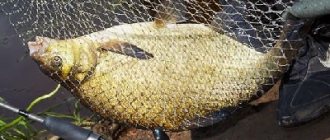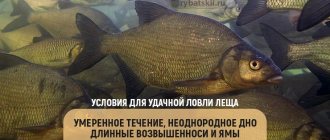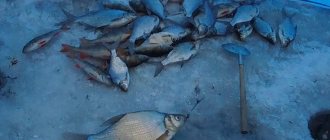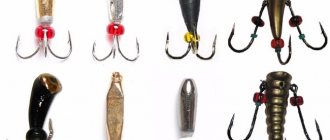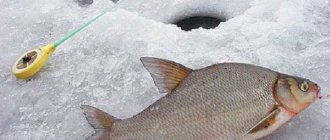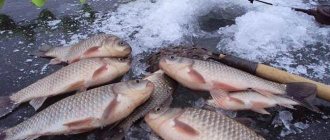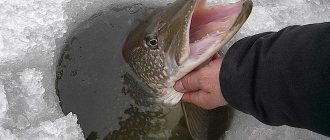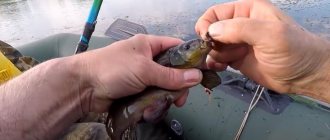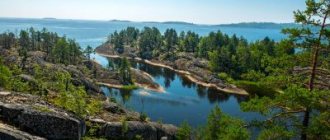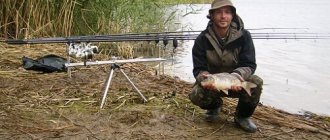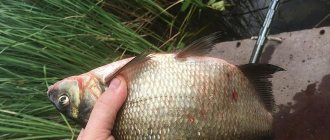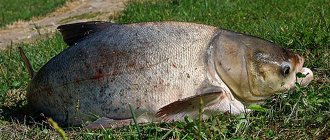Target fishing for bream in winter is the pinnacle of fishing skills. Some believe that this is a difficult and inaccessible type of favorite hobby for the average fisherman. Others cite the fact that due to environmental problems it is already difficult to find this fish. But that's not true. The bream population is still numerous in our reservoirs. There are simply features that need to be taken into account when going winter fishing for this fish.
Features of behavior and life activity
In winter, bream feeds all winter, only the intensity of feeding changes, depending on the weather and environmental conditions. Difficulties in finding bream in winter begin with those fishermen who use tactics usually used when fishing for bream, roach, and crucian carp - as the most common under-ice trophies. Bream in the reservoir occupies a different niche. Against this background, fishermen sometimes make typical mistakes:
- They come to an unfamiliar body of water, without preliminary search or study of the bottom topography, they drill in one place, feed the hole and wait for a bite. This fishing tactic will pay off only if you are lucky enough to get to the spot right away.
- They purposefully find the deepest place and fish there.
- Attempts to hatch large winter bream in shallow water when fishing for bream and roach in the dead of winter.
Pack lifestyle
- The bream spends its entire life in a school. Small undergrowth (laskiri) form loose groups without hierarchy and live in coastal areas and thickets along with roaches, crucian carp and other “small things”. After two to three years, individuals that survive this stage acquire the habits of adult relatives.
- These flocks are denser, small in number (up to several hundred animals), and live in areas with medium depth. Such a group no longer feeds chaotically along the coastline, but makes raids on the most promising points for itself.
- The large bream already leads an adult lifestyle. The pharyngeal teeth are already able to grind small bivalve shells of mollusks and snails, the flocks are not so numerous, there is a hierarchy in them - leader, core and scouts. Such a group lives at great depths, in the same place as large individuals.
- It cannot be said that bream lives sedentary. Yes, the flock lives in a certain water area, a food zone, but does not stand still, but constantly makes raids on promising points. And the fisherman’s task is to find such places. While moving, the fish almost does not feed, only the scouts (the smallest individuals in the school) scurry around the moving cannonball and taste what they come across.
Adults
Large bronze beauties from 2-3 kg to 5 (and more) live in permanent flocks. They have a leader - the largest and oldest individual. The leader leads the rest of the group to the hot spots that he has known for many years. The rest of the bream repeat after him - if the leader feeds, then the whole flock eats. If the alpha runs away, then the pack will rush after him. Such groups number from 5-7 individuals to several dozen (even hundreds, in large reservoirs and lakes).
Therefore, a fishing lure in the form of a bait spot should appeal to the leader, since he decides whether to feed in this particular place or not. It is the main and most cautious bream that cannot be spooked during the fishing process, since the entire flock will follow it.
In water bodies with a large number of fishermen, this works partially, since there are many transitional schools in them - those in which there is no new leader yet, and the old one, for example, has fallen for the fisherman's bait. There is no hierarchy in such groups. They either join others, or a new leader appears in them. The fisherman's task is to find the place where the fish visit for feeding, feed and wait.
Eating Habits
The white bream consumes dozens of species of small crustaceans in its diet. The feeding preferences of adult fish are more constant - a school will not chase two crustaceans across the water area, it comes out day after day, year after year, to the same favorite places rich in food.
- Uneven bottom with rocks in which you can make money.
- Shell beds of zebra mussels or other small bivalves on slopes and tables among the prevailing deep depths are favorite places.
- This fish also likes to swarm in the recesses and under the edges in search of bloodworms, jigs (gammarus) and bristle worms.
- Large bream dig holes in the feeding area to hard ground up to half a meter deep. Using the lateral line, they detect the micromovements of crustaceans and larvae in the depths of bottom sediments and dig the bottom, drawing masses through the mouth and gill covers and then throwing them back into the water.
- The larvae that enter the mouth at this time are distinguished by the fish using taste buds and swallowed. The bream seems to filter the bottom, swallowing food and spitting out inedible particles.
To watch online, click on the video ⤵
How to catch Cold Burbot on Ice Lake [ARCHIVE] | Real Fishing More details
How to catch White Sturgeon on Ice Lake [ARCHIVE] | Real Fishing More details
How to Catch Crystal Pike on Ice Lake [ARCHIVE] | Real Fishing More details
How to Catch Frozen Walleye on Ice Lake [ARCHIVE] | Real Fishing More details
How to catch Ice Roach on Ice Lake [ARCHIVE] | Real Fishing More details
How to catch Burbot on the Lesnaya River [NEW] | Real Fishing More details
How to catch Snow Carp on Ice Lake [ARCHIVE] | Real Fishing More details
How to Catch Christmas Ode on Ice Lake [ARCHIVE] | Real Fishing More details
Real fishing ice lake Read more
How to Catch Northern Carp on Ice Lake [ARCHIVE] | Real Fishing More details
How to catch Arctic stickleback on Ice Lake [ARCHIVE] | Real Fishing More details
GMP "ICE LAKE" REAL FISHING More details
How to catch New Year's catfish on Ice Lake [ARCHIVE] | Real Fishing More details
Real fishing #11 Farming for corn on Ice Lake. Set a record for Carp! More details
How to Catch Winter Bream on Ice Lake [ARCHIVE] | Real Fishing More details
Catching "Burbot" [ARCHIVE] | Real Fishing More details
How to catch Snow White Sturgeon on an icy lake. Real fishing Read more
How to catch Frostbitten Ruff on Ice Lake [ARCHIVE] | Real Fishing More details
How to catch Frosty Perch on Ice Lake [ARCHIVE] | Real Fishing More details
Source
About bait in winter
In accordance with these biological characteristics, the conclusions are:
- When hunting for large bream in winter, we select or look for places that the fish constantly visits for feeding. At a minimum, you need a water area in which bream is present (makes cyclic raids).
- The best bait for winter fishing for bream is live bloodworm or jig. Bream reacts to the movement of the larvae; this is the main attraction factor. Live bloodworms and jigs buried in the bottom can lure a school from a distance of several tens of meters, especially under ice, when the water is very quiet, and force the bream to start feeding here, even if this is not its usual feeding place.
- Worms and maggots also perform this function well, but not for long - after all, these are land animals; in water, these organisms die over time and stop moving.
This creates a kind of fork - in winter you need to either clearly find a feeding place, or use live animal bait, which will stop the bream passing by on its business at the fishing point. Therefore, in winter, baiting methods work well for bream - the fisherman artificially creates a feeding site, which the fish begins to visit constantly.
Pouring a large amount of store-bought bait into one hole while fishing in the hope of attracting a flock will not bring success. This method is more likely to attract winter roach and crucian carp (which will quickly eat their fill and also stop paying attention to the bait of the fishing rod). Bream, especially in winter, are more attracted to the movement of bloodworms than the smell. A small amount of food bloodworms will help activate bream during passive biting in winter. Promotion in stores and advertising of frozen bloodworms is a marketing ploy. The best option in winter is live larvae.
Of course, these are general rules. Feeding bloodworms or live mormysh is difficult and expensive to obtain. Therefore, the majority of fishermen feed them with vegetable baits in winter. This fish has an excellent sense of smell, so a well-chosen mixture of smells will also work. In winter conditions, it is advisable to add at least a little live bloodworm to the bait. Such an additive will increase the protein value of the food, and the movement of the larvae will attract fish from afar in winter.
Live jig
Feeding
The composition of plant bait differs from roach bait in that for bream the feed fraction must be fairly large in size - whole grains, pieces of cake, corn, etc. Fine groundbait will most likely attract silver bream and roach in winter. Scouts can visit a feeding spot, but if there is nothing to eat there, the flock will not come. Clay and sand can be used as ballast, although this is problematic in winter. Bream fishing takes place in winter at great depths, so the bait is lowered using a dump truck.
For fishing in the current, you need to use special feeders (kormak). In winter, the main thing is not to overdo it with the dose of flavoring, so as not to scare off the already wary fish. It is possible to say exactly what smells bream likes only in a specific body of water and at a certain fishing time. You should experiment with all the popular flavors for carp fish, but be very careful. There is no need to get perverted and make a mixture of many smells. In winter, the simpler principle works, the better.
A general winter rule is not to overfeed. It’s better to throw in a little formula and then periodically supplement. The mistake some anglers make is throwing a lot of bait into the hole when the bite is bad or absent. Such an action will not only not bring success, but, on the contrary, will worsen the situation. It is better to throw a pinch of live bloodworms into the hole.
Caution and timidity
The caution of bream is the stuff of legends. There is an opinion that in urbanized areas this fish is the most shy. But bream is cautious by nature, and not because fishermen got it. An experienced leader leads the pack away from any real or dubious threat.
In places visited by fishermen, this fish is already more or less accustomed to the presence of humans. Therefore, contrary to the opinion of the majority, it is in wild and untouched reservoirs when fishing for bream that it is important to maintain special silence - a large leader will never approach and lead the flock to the place if he is alarmed by the manifestation of unknown factors: noise, knocking, shadow.
When to catch
Winter fishing for bream, like many other types of fish, is characterized by high results on the first ice. If 30-40 years ago, the reservoirs of the middle zone were covered with the first ice capable of supporting the weight of a fisherman in early December, now this can only happen by the new year. Increasingly, the weather brings surprises, and ice fishing may not begin until January.
From the second half of January, during the deep winter period, the activity of bream noticeably decreases due to the critically low level of oxygen dissolved in the water. It is quite difficult to achieve a good catch during this period, even if fish kills do not occur in a given reservoir.
As the length of daylight increases, by the end of February the fish leave their wintering pits and begin to migrate. With the start of migration, bream feed intensively before spawning, and ice fishing during this period can give excellent results.
As for daily activity, bream and bream can bite constantly, but the greatest number of bites is observed precisely at night. Well-trained night ice fishing enthusiasts note that trophy specimens are caught precisely at this time.
The key to success in night fishing is careful preparation. In addition to the necessary gear and bait, the arsenal of “night hunters” for bream should have reliable light sources (simple and headlamps), a tent, a gas burner, a thermos with hot tea and a set of very warm clothes and shoes.
Weather
The bite in winter also depends on the weather. Winter bream are most active and feed when there are no sudden jumps or changes. Contrary to popular belief, its activity is more influenced by the presence of oxygen in the water and the presence of food; the weather has an indirect effect.
The debate about the pressure at which bream bites in winter will always continue. But the point is that the observations apply only to a specific body of water. Elsewhere, weather influences will have a different impact on the bite and fishing. Along with the weather, it is necessary to consider other factors - changes in water levels and currents.
Sudden atmospheric changes do not cancel the bite, as is believed, but affect the feeding pattern, including the level of activity of the fish. Therefore, when the weather changes in winter, fishing tactics, tackle, bait, and search locations also change. Cases when, in principle, it does not bite are extremely rare. More often than not, the angler simply cannot find the right keys for the fish.
Where to look for and catch bream in winter
If a cool fishing spot is known in advance, good. But on an unfamiliar body of water, searching for bream in winter turns into a significant component of fishing success. To do this, the fisherman must use his entire arsenal of knowledge and experience. Modern means such as winter echo sounders and ice fishing cameras can also help with this. You should not look for the fish itself on the video camera - the school simply may not be here at that time. But this gadget will help you consider the bottom topography or the presence of a zebra mussel colony, as well as the fish’s reaction to bait and bait.
In the rivers
Studying the shore will help you find bream in small rivers in winter. Deep gullies under cliffs, holes behind a cape after rapids, large deep-sea reaches with stepped side edges and a hard bottom are the most promising places. You should fish under a dump or at the exits of pits. It makes no sense to look for holes in the deepest flat part without vegetation and snags in winter. The fisherman needs any deviations in the relief - holes, tubercles, depth changes, colonies of mollusks.
Search on the river
In large rivers, feeding places for bream in winter should be looked for under dumps, on flat areas, plateaus, banks and tables at riverbed edges. Rock slopes and embankments adjacent to great depths can be very promising for fishing. Reverse currents, eddies that create anomalies in the even bottom topography, are visited by the school in search of food.
In lakes and reservoirs
Finding a fishing spot in reservoirs directly depends on the successful completion of the search. The water area of such reservoirs is huge; the fisherman needs to find the square in which a school of bream makes raids. The most promising places for catching bream in reservoirs in winter are the flooded beds of the main river, ditches of tributaries, numerous pits near dumps, as well as local pits with access to tables with shells and vegetation.
Any irregularities in the bottom, snags, or stones near the riverbed must be checked. On lakes the principle is the same. There are no old channels in such reservoirs, but there are natural bottom anomalies. Islands with significant depths nearby and underwater hills among holes are the best places for winter fishing.
Promising places
Where to look for bream in December
At the beginning of winter and during the first ice, bream gather in larger schools than in summer. This happens spontaneously, as more fish accumulate in smaller areas. During the first ice, schools of bream are still very active; in December, bream are found at average depths of 2-3 meters, where they come out of holes to feed. The raid routes are long and enter relatively shallow areas.
Bream fishing in December is more active - there can be many feeding places for the school, so the bite periodically disappears simply because the school has moved. In this case, you need to continue searching. It is better to catch bream on the first ice lightly, since hatching a school is not promising. It’s easier to walk around the pond with a jig and look for it. The flock can be anywhere, as long as the depth allows.
At the beginning of winter
Glukhozimye
In the middle of winter, bream can no longer be found in shallow water - it has completely moved to winter quarters. These are the same places that we talked about in the first part of the article. Bream fishing in January occurs near its permanent aggregation sites. In the cold season, all fish save energy; a school of bream will not make long raids, preferring feeding places not far from the pit. This is where you need to look.
In the middle of winter
Mastyrka for winter bream
Despite the fact that mastyrka is a vegetable bait. It is used to catch bream on the first and last ice. To prepare it, you need to boil washed yellow peas in the amount of one glass for 30 minutes. After
Allow the peas to cool, and then grind them in a food processor (blender, meat grinder, etc.).
After this, add 1 cup of semolina to the ground peas. Semolina should be added in small portions, each thoroughly mixed with peas. The mastyrka can be considered ready when it becomes a uniform consistency and stops sticking to your hands.
You can add some other ingredients to the mastyrka, depending on what the bream gravitates towards in each particular body of water:
- honey;
- sugar;
- sunflower oil;
- egg.
The finished mastyrka should be divided into portions, wrapped in a thick plastic bag and stored in the freezer. Unfortunately, mastyrka spoils quickly, so it only needs to be prepared for the next 2–3 fishing trips.
Fishing trick: When catching bream in winter, it is advisable to add vitamins to the bait (this can be the most common “Revit”). And it is better to dilute semolina for mastyrka with wheat flour in equal proportions.
How to catch bream in winter
Winter fishing for bream can take place in different conditions, so the types and settings of gear for catching this fish are varied. Gear for winter fishing for bream can be divided into two groups:
- Light winter fishing rods (for fishing in still water).
- Heavy tackle, winter donks (for fishing in the current).
Fishing in still water
For ice fishing for bream on a lake, reservoir or river with a weak current, standard fishing rods, nod or float, are used. Bream fishing rods vary in design and equipment. Fishing in still water allows the use of light equipment and sensitive gear, which is important when the bite is weak. Some specimens of this fish exceed 3 kg; cases of catching five-kilogram individuals also occur.
Therefore, when using thin equipment in winter, it is important to use strong and high-quality fishing line and reliable hooks. When catching capricious fish in still water in winter, use the thinnest fishing lines, preferably special winter fluorocarbon, frost-resistant and practically invisible. The water is clear in winter, and excessively rough equipment can alert fish, especially large ones.
Fishing rods for bream:
They successfully catch bream in winter and with jigs, especially at the beginning and end of winter. Many anglers practice fishing with devils and other reelless baits. This fish responds well to smooth, slow vibrations. Fishing methods are often combined, which allows you to quickly find a catchable option.
Read our article about catching bream with a jig:
https://podlednik.ru/lovlya_zimoj/na-mormyshku/mormyshki-na-leshha-zimoj
On the current
Fishing for bream in winter on a river with a strong current requires special heavy gear. And a huge number of them have been invented. The most popular and effective are the bream descender (combine) and the roller. Locomotives of jigs, garlands, and various options for winter donks are suitable for this type of fishing in winter. For a detailed overview of these methods, read the article about catching this fish in the current:
https://podlednik.ru/lovlya_zimoj/zimnie-donki/lovlya-leshha-na-techenii
How to Catch Winter Bream on Ice Lake [ARCHIVE] | Real Fishing
Pokazuvati elementi keruvannya progravachem
- Published on June 30, 2019
- We fish for “Winter Bream” at the location “Ice Lake”. =====================================================
